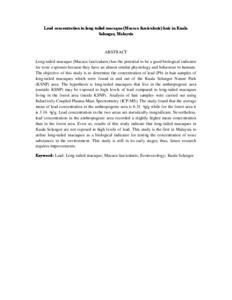Citation
Hassim, Nurul Ashikin and Kambali @ Hambali, Kamarul Ariffin and Idris, Nor Shahirul Umirah and Mohamad Amir Hamzah, Aainaa Syazwani and Ismail, Ahmad and Zulkifli, Syaizwan Zahmir and Sow, Ai Yin
(2018)
Lead concentration in long-tailed macaque (Macaca fascicularis) hair in Kuala Selangor, Malaysia.
Tropical Life Sciences Research, 29 (2).
pp. 175-186.
ISSN 1985-3718; ESSN: 2180-4249
Abstract
Long-tailed macaque (Macaca fascicularis) has the potential to be a good biological indicator for toxic exposure because they have an almost similar physiology and behaviour to humans. The objective of this study is to determine the concentration of lead (Pb) in hair samples of long-tailed macaques which were found in and out of the Kuala Selangor Nature Park (KSNP) area. The hypothesis is long-tailed macaques that live in the anthropogenic area (outside KSNP) may be exposed to high levels of lead compared to long-tailed macaques living in the forest area (inside KSNP). Analysis of hair samples were carried out using Inductively Coupled Plasma-Mass Spectrometry (ICP-MS). The study found that the average mean of lead concentration in the anthropogenic area is 6.31 μg/g while for the forest area it is 3.16 μg/g. Lead concentration in the two areas are statistically insignificant. Nevertheless, lead concentration in the anthropogenic area recorded a slightly higher mean concentration than in the forest area. Even so, results of this study indicate that long-tailed macaques in Kuala Selangor are not exposed to high levels of lead. This study is the first in Malaysia to utilise long-tailed macaques as a biological indicator for testing the concentration of toxic substances in the environment. This study is still in its early stages; thus, future research requires improvements.
Download File
![[img]](http://psasir.upm.edu.my/69854/1.hassmallThumbnailVersion/Lead%20concentration%20in%20long-tailed%20macaque%20%28Macaca%20fascicularis%29%20hair%20in%20Kuala%20Selangor%2C%20Malaysia.pdf)  Preview |
|
Text (Abstract)
Lead concentration in long-tailed macaque (Macaca fascicularis) hair in Kuala Selangor, Malaysia.pdf
Download (50kB)
| Preview
|
|
Additional Metadata
Actions (login required)
 |
View Item |

